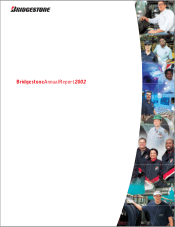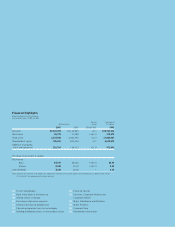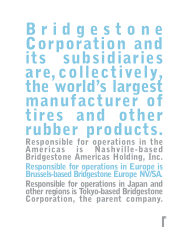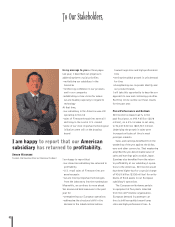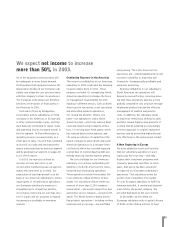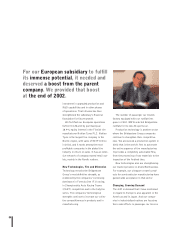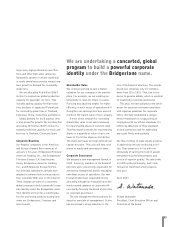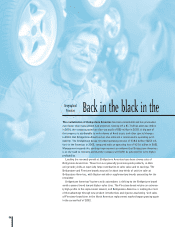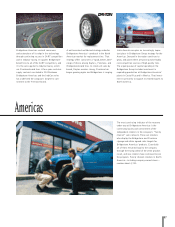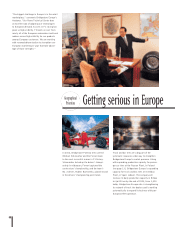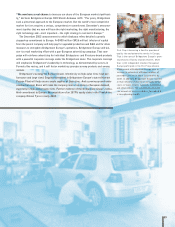Bridgestone 2002 Annual Report Download - page 5
Download and view the complete annual report
Please find page 5 of the 2002 Bridgestone annual report below. You can navigate through the pages in the report by either clicking on the pages listed below, or by using the keyword search tool below to find specific information within the annual report.
03
lot of the equipment at those plants will
be inadequate to serve future demand.
Writing down that equipment reduces the
depreciation burden at our European sub-
sidiary and aligns the cost structure there
with the company’s actual circumstances.
The European write-downs are therefore
similar to write-downs of fixed assets in
the Americas in 2001.
Unit sales of tires by Bridgestone
Corporation and its subsidiaries in 2002
increased in the Americas, in Europe and
in other markets besides Japan, and they
were basically unchanged in Japan. Sales
and operating income increased overall in
the tire segment. In diversified products,
operating income increased solidly on a
small gain in sales. You will find a detailed
account of our sales and earnings perfor-
mance and projections by business segment
and by geographical segment on pages 18
to 23 of this report.
In 2003, we expect to achieve an
increase of more than 50% in net
income while maintaining sales at approxi-
mately the same level as in 2002. Our
expectation of earnings growth is on the
basis of our American subsidiary’s continu-
ing progress in revitalizing its operations,
our European subsidiary’s progress in
strengthening its competitive position,
our progress improving our earnings struc-
ture in Japan and our progress in expand-
ing operations profitably in emerging
markets.
Continuing Recovery in the Americas
The return to profitability at our American
subsidiary in 2002 vindicated the sweeping
measures taken there in 2001. Those
measures included (1) reorganizing North
American operations to sharpen the focus
on management responsibility for prof-
itability in different sectors, such as North
American tire operations, retail operations
and diversified products operations;
(2) closing the Decatur, Illinois, tire
plant—our subsidiary’s oldest North
American plant—which has reduced fixed
costs and raised overall capacity utiliza-
tion; (3) writing down fixed assets, which
has reduced depreciation expense; and
(4) using an infusion of capital from the
parent company to place North and Latin
American operations on a stronger finan-
cial footing, which has included repaying
a great deal of interest-bearing debt and
thereby reducing interest expense greatly.
The core challenge for our American
subsidiary is to achieve sustainable prof-
itability in its North American tire manu-
facturing and wholesaling operations.
Those operations remain the weakest link
in an otherwise robust portfolio of busi-
nesses. Our subsidiary’s North American
network of more than 2,200 company-
owned stores—the world’s largest tire and
automotive service network—remains prof-
itable. The North America–based diversi-
fied products operations—including roofing
materials and air springs—are profitable
and growing. The Latin American tire
operations are—notwithstanding the recent
economic instability in Argentina and
Venezuela—fundamentally profitable and
extremely promising.
Raising profitability in our subsidiary’s
North American tire operations will
depend on several factors, including ensur-
ing that those operations develop a more
globally competitive cost structure through
heightened productivity and the effective
management of medical and pension
costs. In addition, the subsidiary needs
to maximize revenues by shifting its sales
portfolio toward higher-value products. It
is doing that by adopting an increasingly
selective approach in original equipment
business and by promoting high-end prod-
ucts effectively in the replacement market.
A New Beginning in Europe
We have abided by a policy of insisting
that our subsidiary operations in each
region pay their own way—that they
finance their investment programs with
internally generated cash flow. In retro-
spect, that policy has been unrealistic
in regard to our European subsidiary’s
operations. That subsidiary serves the
world’s most competitive tire market.
For our European subsidiary to fulfill its
immense potential, it needed and deserved
a boost from the parent company. We
provided that boost at the end of 2002.
In December, we furnished our
European subsidiary with a capital infusion
of E400 million ($416 million) to fund
We expect net income to increase
more than 50% in 2003.

